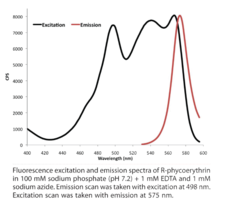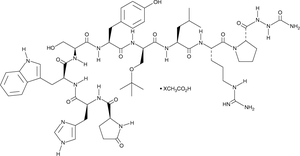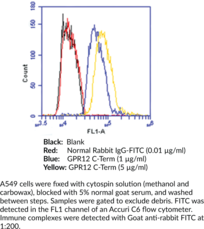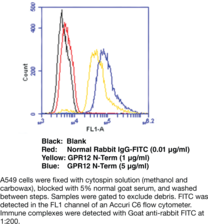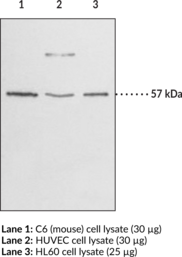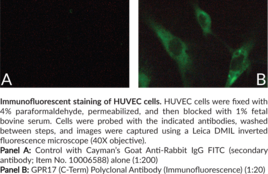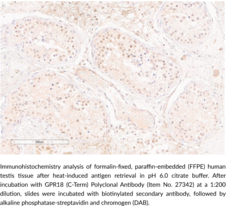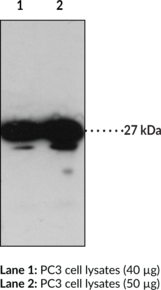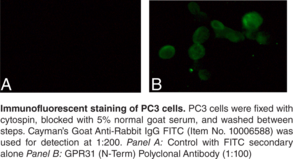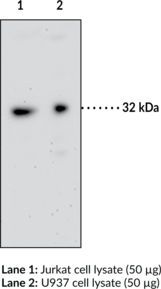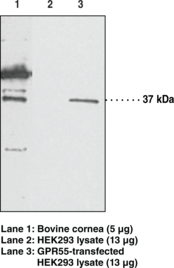Cayman
Showing 22651–22800 of 45550 results
-
Brand:CaymanSKU:16589- 100 µg
Goat F(Ab’)2 anti-Mouse IgG, H+L conjugated to SureLight® APC Antibody: Goat F(ab’)2 polyclonal anti-Mouse IgG Dye: SureLight® Allophycocyanin (APC) Excitation max. λ: 650 nm Emission max. λ: 660 nm Uses: Flow Cytometry and cell-based assays
Brand:CaymanSKU:16589 - 100 µgAvailable on backorder
Goat F(Ab’)2 anti-Mouse IgG, H+L conjugated to SureLight® R-PE Antibody: Goat F(Ab’)2 polyclonal anti-Mouse IgG Dye: SureLight® R-phycoerythrin Excitation max. λ: 565>498 nm Emission max. λ: 578 nm Uses: Flow cytometry, cell-based assays, microarrays, and microplate applications
Brand:CaymanSKU:16647 - 100 µgAvailable on backorder
Brand:CaymanSKU:16647- 100 µgAvailable on backorder
Brand:CaymanSKU:16647- 100 µgBrand:CaymanSKU:16590- 100 µgAvailable on backorder
Brand:CaymanSKU:16590- 100 µgGoat F(Ab’)2 anti-Mouse IgG, Fc-specific conjugated to SureLight® APC Antibody: Goat F(Ab’)2 polyclonal anti-Mouse IgG, Fc-specifc Dye: SureLight® Allophycocyanin (APC) Excitation max. λ: 650 nm Emission max. λ: 660 nm Uses: Flow Cytometry and cell-based assays
Brand:CaymanSKU:16590 - 100 µgAvailable on backorder
Goat F(Ab’)2 anti-Mouse IgG, Fc-specific conjugated to SureLight® R-PE Antibody: Goat F(Ab’)2 polyclonal anti-Mouse IgG, Fc-specific Dye: SureLight® R-phycoerythrin Excitation max. λ: 565>498 nm Emission max. λ: 578 nm Uses: Flow cytometry, cell-based assays, microarrays, and microplate applications
Brand:CaymanSKU:16648 - 100 µgAvailable on backorder
Brand:CaymanSKU:16648- 100 µgAvailable on backorder
Brand:CaymanSKU:16648- 100 µgBrand:CaymanSKU:16594- 100 µgAvailable on backorder
Brand:CaymanSKU:16594- 100 µgGoat F(Ab’)2 anti-Rat IgG conjugated to SureLight® APC Antibody: Goat F(Ab’)2 polyclonal anti-Rat IgG Dye: SureLight® Allophycocyanin (APC) Excitation max. λ: 650 nm Emission max. λ: 660 nm Uses: Flow Cytometry and cell-based assays
Brand:CaymanSKU:16594 - 100 µgAvailable on backorder
Goat F(Ab’)2 anti-Rat IgG conjugated to SureLight® R-PE Antibody: Goat F(Ab’)2 polyclonal anti-Rat IgG Dye: SureLight® R-phycoerythrin Excitation max. λ: 565>498 nm Emission max. λ: 578 nm Uses: Flow cytometry, cell-based assays, microarrays, and microplate applications
Brand:CaymanSKU:16653 - 100 µgAvailable on backorder
Brand:CaymanSKU:16653- 100 µgAvailable on backorder
Brand:CaymanSKU:16653- 100 µgADP-ribosylation factor 1 (Arf1), when activated by guanine nucleotide exchange factors (ArfGEFs), plays a key role in regulating secretory traffic and membrane transport within the Golgi of eukaryotic cells. Golgicide A is a reversible inhibitor of the brefeldin A (Item No. 11861)-resistant, cis-Golgi ArfGEF, GBF1 (IC50 = 3.3 µM).{30064} Inhibition of GBF1 via golgicide A can result in rapid dissociation of COPI vesicle coat protein from Golgi membranes and disassembly of the Golgi and trans-Golgi network.{30064} Golgicide A does not affect the association of the adaptor protein, AP-1, or the Arf1-binding protein, GCA3, with the trans-Golgi network nor does it interfere with the activity of the ArfGEFs, BIG1 or 2.{30064} Golgicide A can arrest the secretion of soluble and membrane-associated proteins at the ER-Golgi intermediate compartment, as well as prevent endocytic transport of Shiga toxin to the trans-Golgi network.{30064}
Brand:CaymanSKU:-Available on backorder
ADP-ribosylation factor 1 (Arf1), when activated by guanine nucleotide exchange factors (ArfGEFs), plays a key role in regulating secretory traffic and membrane transport within the Golgi of eukaryotic cells. Golgicide A is a reversible inhibitor of the brefeldin A (Item No. 11861)-resistant, cis-Golgi ArfGEF, GBF1 (IC50 = 3.3 µM).{30064} Inhibition of GBF1 via golgicide A can result in rapid dissociation of COPI vesicle coat protein from Golgi membranes and disassembly of the Golgi and trans-Golgi network.{30064} Golgicide A does not affect the association of the adaptor protein, AP-1, or the Arf1-binding protein, GCA3, with the trans-Golgi network nor does it interfere with the activity of the ArfGEFs, BIG1 or 2.{30064} Golgicide A can arrest the secretion of soluble and membrane-associated proteins at the ER-Golgi intermediate compartment, as well as prevent endocytic transport of Shiga toxin to the trans-Golgi network.{30064}
Brand:CaymanSKU:-Available on backorder
ADP-ribosylation factor 1 (Arf1), when activated by guanine nucleotide exchange factors (ArfGEFs), plays a key role in regulating secretory traffic and membrane transport within the Golgi of eukaryotic cells. Golgicide A is a reversible inhibitor of the brefeldin A (Item No. 11861)-resistant, cis-Golgi ArfGEF, GBF1 (IC50 = 3.3 µM).{30064} Inhibition of GBF1 via golgicide A can result in rapid dissociation of COPI vesicle coat protein from Golgi membranes and disassembly of the Golgi and trans-Golgi network.{30064} Golgicide A does not affect the association of the adaptor protein, AP-1, or the Arf1-binding protein, GCA3, with the trans-Golgi network nor does it interfere with the activity of the ArfGEFs, BIG1 or 2.{30064} Golgicide A can arrest the secretion of soluble and membrane-associated proteins at the ER-Golgi intermediate compartment, as well as prevent endocytic transport of Shiga toxin to the trans-Golgi network.{30064}
Brand:CaymanSKU:-Available on backorder
Golvatinib is an orally bioavailable dual inhibitor of the receptor tyrosine kinases c-Met and VEGF receptor 2 (VEGFR2), which are involved in tumor progression.{41051} Golvatinib inhibits autophosphorylation of c-Met in MKN45 cells and phosphorylation of VEGFR2 in human umbilical vein endothelial cells (HUVECs; IC50s = 14 and 16 nM, respectively). It also inhibits proliferation of a variety of cancer cell lines and of HUVECs stimulated with hepatocyte growth factor (HGF) and VEGF but not bFGF (IC50s = 17, 84, and >1,000 nM for HGF-, VEGF-, and bFGF-stimulated HUVECs, respectively). In nude mouse xenograft models using MKN45, Hs746T, SNU-5, or EBC-1 cancer cells, golvatinib (25-200 mg/kg, daily) dose-dependently reduces tumor volume, and it increases survival in the model using MKN45 cells.
Brand:CaymanSKU:22143 -Out of stock
Golvatinib is an orally bioavailable dual inhibitor of the receptor tyrosine kinases c-Met and VEGF receptor 2 (VEGFR2), which are involved in tumor progression.{41051} Golvatinib inhibits autophosphorylation of c-Met in MKN45 cells and phosphorylation of VEGFR2 in human umbilical vein endothelial cells (HUVECs; IC50s = 14 and 16 nM, respectively). It also inhibits proliferation of a variety of cancer cell lines and of HUVECs stimulated with hepatocyte growth factor (HGF) and VEGF but not bFGF (IC50s = 17, 84, and >1,000 nM for HGF-, VEGF-, and bFGF-stimulated HUVECs, respectively). In nude mouse xenograft models using MKN45, Hs746T, SNU-5, or EBC-1 cancer cells, golvatinib (25-200 mg/kg, daily) dose-dependently reduces tumor volume, and it increases survival in the model using MKN45 cells.
Brand:CaymanSKU:22143 -Out of stock
Golvatinib is an orally bioavailable dual inhibitor of the receptor tyrosine kinases c-Met and VEGF receptor 2 (VEGFR2), which are involved in tumor progression.{41051} Golvatinib inhibits autophosphorylation of c-Met in MKN45 cells and phosphorylation of VEGFR2 in human umbilical vein endothelial cells (HUVECs; IC50s = 14 and 16 nM, respectively). It also inhibits proliferation of a variety of cancer cell lines and of HUVECs stimulated with hepatocyte growth factor (HGF) and VEGF but not bFGF (IC50s = 17, 84, and >1,000 nM for HGF-, VEGF-, and bFGF-stimulated HUVECs, respectively). In nude mouse xenograft models using MKN45, Hs746T, SNU-5, or EBC-1 cancer cells, golvatinib (25-200 mg/kg, daily) dose-dependently reduces tumor volume, and it increases survival in the model using MKN45 cells.
Brand:CaymanSKU:22143 -Out of stock
Golvatinib is an orally bioavailable dual inhibitor of the receptor tyrosine kinases c-Met and VEGF receptor 2 (VEGFR2), which are involved in tumor progression.{41051} Golvatinib inhibits autophosphorylation of c-Met in MKN45 cells and phosphorylation of VEGFR2 in human umbilical vein endothelial cells (HUVECs; IC50s = 14 and 16 nM, respectively). It also inhibits proliferation of a variety of cancer cell lines and of HUVECs stimulated with hepatocyte growth factor (HGF) and VEGF but not bFGF (IC50s = 17, 84, and >1,000 nM for HGF-, VEGF-, and bFGF-stimulated HUVECs, respectively). In nude mouse xenograft models using MKN45, Hs746T, SNU-5, or EBC-1 cancer cells, golvatinib (25-200 mg/kg, daily) dose-dependently reduces tumor volume, and it increases survival in the model using MKN45 cells.
Brand:CaymanSKU:22143 -Out of stock
Gomisin C, a lignan first isolated from the fruits of S. chinensis, scavenges oxygen radicals and reduces the production of reactive oxygen species by inhibiting neutrophil activity.{30125} It has been shown to attenuate respiratory burst in rat peripheral neutrophils via suppression of NADPH oxidase (39% inhibition at 30 µg/ml) and inhibition of cytosolic calcium release from intracellular stores (36% inhibition at 50 µg/ml).{30126} Gomisin C can induce liver microsomal cytochrome P450, thus facilitating the clearance of xenobiotics and protecting against hepatotoxicity in rodent models of liver injury.{30124}
Brand:CaymanSKU:-Available on backorder
Gomisin C, a lignan first isolated from the fruits of S. chinensis, scavenges oxygen radicals and reduces the production of reactive oxygen species by inhibiting neutrophil activity.{30125} It has been shown to attenuate respiratory burst in rat peripheral neutrophils via suppression of NADPH oxidase (39% inhibition at 30 µg/ml) and inhibition of cytosolic calcium release from intracellular stores (36% inhibition at 50 µg/ml).{30126} Gomisin C can induce liver microsomal cytochrome P450, thus facilitating the clearance of xenobiotics and protecting against hepatotoxicity in rodent models of liver injury.{30124}
Brand:CaymanSKU:-Available on backorder
Gomisin C, a lignan first isolated from the fruits of S. chinensis, scavenges oxygen radicals and reduces the production of reactive oxygen species by inhibiting neutrophil activity.{30125} It has been shown to attenuate respiratory burst in rat peripheral neutrophils via suppression of NADPH oxidase (39% inhibition at 30 µg/ml) and inhibition of cytosolic calcium release from intracellular stores (36% inhibition at 50 µg/ml).{30126} Gomisin C can induce liver microsomal cytochrome P450, thus facilitating the clearance of xenobiotics and protecting against hepatotoxicity in rodent models of liver injury.{30124}
Brand:CaymanSKU:-Available on backorder
Gomisin C, a lignan first isolated from the fruits of S. chinensis, scavenges oxygen radicals and reduces the production of reactive oxygen species by inhibiting neutrophil activity.{30125} It has been shown to attenuate respiratory burst in rat peripheral neutrophils via suppression of NADPH oxidase (39% inhibition at 30 µg/ml) and inhibition of cytosolic calcium release from intracellular stores (36% inhibition at 50 µg/ml).{30126} Gomisin C can induce liver microsomal cytochrome P450, thus facilitating the clearance of xenobiotics and protecting against hepatotoxicity in rodent models of liver injury.{30124}
Brand:CaymanSKU:-Available on backorder
Gomisin D is a lignan that has been found in S. chinensis and has diverse biological activities, including enzyme inhibitory and antioxidant properties.{52842,52843,47352} It inhibits acetylcholinesterase (AChE) with an IC50 value of 7.84 µM.{52842} Gomisin D scavenges ABTS (Item No. 27317) and 2,2-diphenyl-1-picrylhydrazyl (DPPH; Item No. 14805) radicals (IC50s = 24.5 and 203 µM, respectively).{47352} It inhibits the UDP-glucuronosyltransferase (UGT) isoforms UGT1A1 and UGT1A3 by 89.9 and 83.1%, respectively, when used at a concentration of 100 µM.{52843} It is selective for UGT1A1 and UGT1A3 over other UGT isoforms at 100 µM.
Brand:CaymanSKU:30697 - 1 mgAvailable on backorder
Gomisin D is a lignan that has been found in S. chinensis and has diverse biological activities, including enzyme inhibitory and antioxidant properties.{52842,52843,47352} It inhibits acetylcholinesterase (AChE) with an IC50 value of 7.84 µM.{52842} Gomisin D scavenges ABTS (Item No. 27317) and 2,2-diphenyl-1-picrylhydrazyl (DPPH; Item No. 14805) radicals (IC50s = 24.5 and 203 µM, respectively).{47352} It inhibits the UDP-glucuronosyltransferase (UGT) isoforms UGT1A1 and UGT1A3 by 89.9 and 83.1%, respectively, when used at a concentration of 100 µM.{52843} It is selective for UGT1A1 and UGT1A3 over other UGT isoforms at 100 µM.
Brand:CaymanSKU:30697 - 10 mgAvailable on backorder
Gomisin D is a lignan that has been found in S. chinensis and has diverse biological activities, including enzyme inhibitory and antioxidant properties.{52842,52843,47352} It inhibits acetylcholinesterase (AChE) with an IC50 value of 7.84 µM.{52842} Gomisin D scavenges ABTS (Item No. 27317) and 2,2-diphenyl-1-picrylhydrazyl (DPPH; Item No. 14805) radicals (IC50s = 24.5 and 203 µM, respectively).{47352} It inhibits the UDP-glucuronosyltransferase (UGT) isoforms UGT1A1 and UGT1A3 by 89.9 and 83.1%, respectively, when used at a concentration of 100 µM.{52843} It is selective for UGT1A1 and UGT1A3 over other UGT isoforms at 100 µM.
Brand:CaymanSKU:30697 - 5 mgAvailable on backorder
Gomisin J is a lignan that has been found in Schisandra chinensis and has diverse biological activities.{52505,52506} It inhibits HIV-1 IIIB replication in H9 T cells (EC50 = 1.5 µg/ml).{52505} Gomisin J (20 µM) decreases LPS-induced increases in nitric oxide (NO) production and p38, ERK, and JNK phosphorylation in RAW 264.7 cells.{52506} It induces relaxation of isolated, precontracted endothelium-intact rat aortic rings when used at concentrations of 3, 10, and 30 µg/ml.{52508} Gomisin J is cytotoxic to 13 cancer cell lines, including breast, colon, and cervical cancer cells, when used at a concentration of 30 µg/ml.{52507}
Brand:CaymanSKU:30213 - 1 mgAvailable on backorder
Gomisin J is a lignan that has been found in Schisandra chinensis and has diverse biological activities.{52505,52506} It inhibits HIV-1 IIIB replication in H9 T cells (EC50 = 1.5 µg/ml).{52505} Gomisin J (20 µM) decreases LPS-induced increases in nitric oxide (NO) production and p38, ERK, and JNK phosphorylation in RAW 264.7 cells.{52506} It induces relaxation of isolated, precontracted endothelium-intact rat aortic rings when used at concentrations of 3, 10, and 30 µg/ml.{52508} Gomisin J is cytotoxic to 13 cancer cell lines, including breast, colon, and cervical cancer cells, when used at a concentration of 30 µg/ml.{52507}
Brand:CaymanSKU:30213 - 10 mgAvailable on backorder
Gomisin J is a lignan that has been found in Schisandra chinensis and has diverse biological activities.{52505,52506} It inhibits HIV-1 IIIB replication in H9 T cells (EC50 = 1.5 µg/ml).{52505} Gomisin J (20 µM) decreases LPS-induced increases in nitric oxide (NO) production and p38, ERK, and JNK phosphorylation in RAW 264.7 cells.{52506} It induces relaxation of isolated, precontracted endothelium-intact rat aortic rings when used at concentrations of 3, 10, and 30 µg/ml.{52508} Gomisin J is cytotoxic to 13 cancer cell lines, including breast, colon, and cervical cancer cells, when used at a concentration of 30 µg/ml.{52507}
Brand:CaymanSKU:30213 - 5 mgAvailable on backorder
Gonadorelin is a tropic hormone and agonist of the gonadotropin-releasing hormone receptor (GNRHR; Ki = 13 nM in CHO cells expressing the human receptor).{36464} It stimulates luteinizing hormone (LH) and follicle-stimulating hormone (FSH) release from rat anterior pituitary cultures when administered at a dose of 0.1 μg.{40777} It also stimulates LH release from bovine anterior pituitary cultures at a concentration of 1 μM.{40778} In vivo, gonadorelin induces ovulation in rats pretreated with fluphenazine (Item No. 23555; ED50 = 610.3 ng/kg).{40779} Formulations containing gonadorelin have been used as diagnostic agents to assess pituitary gland function.
Brand:CaymanSKU:24240 - 10 mgAvailable on backorder
Gonadorelin is a tropic hormone and agonist of the gonadotropin-releasing hormone receptor (GNRHR; Ki = 13 nM in CHO cells expressing the human receptor).{36464} It stimulates luteinizing hormone (LH) and follicle-stimulating hormone (FSH) release from rat anterior pituitary cultures when administered at a dose of 0.1 μg.{40777} It also stimulates LH release from bovine anterior pituitary cultures at a concentration of 1 μM.{40778} In vivo, gonadorelin induces ovulation in rats pretreated with fluphenazine (Item No. 23555; ED50 = 610.3 ng/kg).{40779} Formulations containing gonadorelin have been used as diagnostic agents to assess pituitary gland function.
Brand:CaymanSKU:24240 - 25 mgAvailable on backorder
Gonadorelin is a tropic hormone and agonist of the gonadotropin-releasing hormone receptor (GNRHR; Ki = 13 nM in CHO cells expressing the human receptor).{36464} It stimulates luteinizing hormone (LH) and follicle-stimulating hormone (FSH) release from rat anterior pituitary cultures when administered at a dose of 0.1 μg.{40777} It also stimulates LH release from bovine anterior pituitary cultures at a concentration of 1 μM.{40778} In vivo, gonadorelin induces ovulation in rats pretreated with fluphenazine (Item No. 23555; ED50 = 610.3 ng/kg).{40779} Formulations containing gonadorelin have been used as diagnostic agents to assess pituitary gland function.
Brand:CaymanSKU:24240 - 5 mgAvailable on backorder
Goserelin is a synthetic gonadotropin-releasing hormone (GNRH) agonist that binds to the GNRH receptor (GNRHR; Ki = 1.6 nM, in CHO cells expressing the human receptor).{36464} It binds to mouse pituitary αT3-1 cells and human placenta (Kds = 2 and 580 nM, respectively) and increases intracellular calcium in αT3-1 cells.{36465} Goserelin induces testosterone production in vitro within 4 h in rat Leydig cells (ED50 = 83 nM) but decreases testosterone plasma level in vivo in rats over a period of 2 to 24 weeks.{36466,36467} It inhibits tumor growth in a DU145 human prostate carcinoma mouse xenograft model when administered at a dose of 100 μg per day.{36468} Formulations containing goserelin have been used in the treatment of hormone-dependent breast and prostate cancers, as well as endometriosis and uterine fibroids.
Brand:CaymanSKU:24071 - 1 mgAvailable on backorder
Goserelin is a synthetic gonadotropin-releasing hormone (GNRH) agonist that binds to the GNRH receptor (GNRHR; Ki = 1.6 nM, in CHO cells expressing the human receptor).{36464} It binds to mouse pituitary αT3-1 cells and human placenta (Kds = 2 and 580 nM, respectively) and increases intracellular calcium in αT3-1 cells.{36465} Goserelin induces testosterone production in vitro within 4 h in rat Leydig cells (ED50 = 83 nM) but decreases testosterone plasma level in vivo in rats over a period of 2 to 24 weeks.{36466,36467} It inhibits tumor growth in a DU145 human prostate carcinoma mouse xenograft model when administered at a dose of 100 μg per day.{36468} Formulations containing goserelin have been used in the treatment of hormone-dependent breast and prostate cancers, as well as endometriosis and uterine fibroids.
Brand:CaymanSKU:24071 - 10 mgAvailable on backorder
Goserelin is a synthetic gonadotropin-releasing hormone (GNRH) agonist that binds to the GNRH receptor (GNRHR; Ki = 1.6 nM, in CHO cells expressing the human receptor).{36464} It binds to mouse pituitary αT3-1 cells and human placenta (Kds = 2 and 580 nM, respectively) and increases intracellular calcium in αT3-1 cells.{36465} Goserelin induces testosterone production in vitro within 4 h in rat Leydig cells (ED50 = 83 nM) but decreases testosterone plasma level in vivo in rats over a period of 2 to 24 weeks.{36466,36467} It inhibits tumor growth in a DU145 human prostate carcinoma mouse xenograft model when administered at a dose of 100 μg per day.{36468} Formulations containing goserelin have been used in the treatment of hormone-dependent breast and prostate cancers, as well as endometriosis and uterine fibroids.
Brand:CaymanSKU:24071 - 5 mgAvailable on backorder
Gossypol is a racemic mixture of natural polyphenols isolated from parts of the cotton plant (genus Gossypium). It causes infertility in a variety of cotton pests and spermatogenesis arrest in humans.{23003} Gossypol also has antimalarial properties, preventing the growth of P. falciparum at low micromolar concentrations.{23001} It inhibits aldose reductase (Ki = 0.5 µM).{23002} Gossypol also acts as an anticancer agent, inhibiting cell growth in various cancer cell lines, in part by blocking the anti-apoptotic functions of Bcl-2 and Bcl-xL, again at low micromolar concentrations.{23000}
Brand:CaymanSKU:-Gossypol is a racemic mixture of natural polyphenols isolated from parts of the cotton plant (genus Gossypium). It causes infertility in a variety of cotton pests and spermatogenesis arrest in humans.{23003} Gossypol also has antimalarial properties, preventing the growth of P. falciparum at low micromolar concentrations.{23001} It inhibits aldose reductase (Ki = 0.5 µM).{23002} Gossypol also acts as an anticancer agent, inhibiting cell growth in various cancer cell lines, in part by blocking the anti-apoptotic functions of Bcl-2 and Bcl-xL, again at low micromolar concentrations.{23000}
Brand:CaymanSKU:-Gossypol is a racemic mixture of natural polyphenols isolated from parts of the cotton plant (genus Gossypium). It causes infertility in a variety of cotton pests and spermatogenesis arrest in humans.{23003} Gossypol also has antimalarial properties, preventing the growth of P. falciparum at low micromolar concentrations.{23001} It inhibits aldose reductase (Ki = 0.5 µM).{23002} Gossypol also acts as an anticancer agent, inhibiting cell growth in various cancer cell lines, in part by blocking the anti-apoptotic functions of Bcl-2 and Bcl-xL, again at low micromolar concentrations.{23000}
Brand:CaymanSKU:-Gossypol is a racemic mixture of natural polyphenols isolated from parts of the cotton plant (genus Gossypium). It causes infertility in a variety of cotton pests and spermatogenesis arrest in humans.{23003} Gossypol also has antimalarial properties, preventing the growth of P. falciparum at low micromolar concentrations.{23001} It inhibits aldose reductase (Ki = 0.5 µM).{23002} Gossypol also acts as an anticancer agent, inhibiting cell growth in various cancer cell lines, in part by blocking the anti-apoptotic functions of Bcl-2 and Bcl-xL, again at low micromolar concentrations.{23000}
Brand:CaymanSKU:-Nicotinamide phosphoribosyltransferase (Nampt) converts nicotinamide into nicotinamide mononucleotide (NMN), which is subsequently converted to NAD+ by NMN adenyltransferase. Cancer cells commonly have an unusually high rate of NAD+ turnover, suggesting that inhibition of Nampt might selectively target cancer cells. GPP 78 is a potent inhibitor of Nampt (IC50 = 3 nM).{17893} It induces cell death in the neuroblastoma cell line SH-SY5Y with an IC50 value of 3.8 nM through a process that appears to involve autophagy.{13670}
Brand:CaymanSKU:-Nicotinamide phosphoribosyltransferase (Nampt) converts nicotinamide into nicotinamide mononucleotide (NMN), which is subsequently converted to NAD+ by NMN adenyltransferase. Cancer cells commonly have an unusually high rate of NAD+ turnover, suggesting that inhibition of Nampt might selectively target cancer cells. GPP 78 is a potent inhibitor of Nampt (IC50 = 3 nM).{17893} It induces cell death in the neuroblastoma cell line SH-SY5Y with an IC50 value of 3.8 nM through a process that appears to involve autophagy.{13670}
Brand:CaymanSKU:-Nicotinamide phosphoribosyltransferase (Nampt) converts nicotinamide into nicotinamide mononucleotide (NMN), which is subsequently converted to NAD+ by NMN adenyltransferase. Cancer cells commonly have an unusually high rate of NAD+ turnover, suggesting that inhibition of Nampt might selectively target cancer cells. GPP 78 is a potent inhibitor of Nampt (IC50 = 3 nM).{17893} It induces cell death in the neuroblastoma cell line SH-SY5Y with an IC50 value of 3.8 nM through a process that appears to involve autophagy.{13670}
Brand:CaymanSKU:-Nicotinamide phosphoribosyltransferase (Nampt) converts nicotinamide into nicotinamide mononucleotide (NMN), which is subsequently converted to NAD+ by NMN adenyltransferase. Cancer cells commonly have an unusually high rate of NAD+ turnover, suggesting that inhibition of Nampt might selectively target cancer cells. GPP 78 is a potent inhibitor of Nampt (IC50 = 3 nM).{17893} It induces cell death in the neuroblastoma cell line SH-SY5Y with an IC50 value of 3.8 nM through a process that appears to involve autophagy.{13670}
Brand:CaymanSKU:-G protein-coupled receptor 12 (GPR12) is a high affinity receptor for sphingosine-1-phosphate, sphingosyl-phosphorylcholine and tyrosol that is expressed in brain, pituitary, ovary, and testis tissues.{22366,22367,22368,22364,22365} GPR12 plays a role in neuronal differentiation, neuronal growth and the formation of synaptic contacts.{22365,22367} Cayman’s GPR12 receptor (C-Term) polyclonal antibody can be used for flow cytometry and immunocytochemistry of GPR12 on human samples.
Brand:CaymanSKU:14266 - 1 eaAvailable on backorder
Immunogen: synthetic peptide from the C-terminal region of human GPR12 • Host: rabbit • Cross Reactivity: (+) human GPR12 receptor • Application(s): FC and ICC
Brand:CaymanSKU:14266- 1 eaAvailable on backorder
Immunogen: synthetic peptide from the C-terminal region of human GPR12 • Host: rabbit • Cross Reactivity: (+) human GPR12 receptor • Application(s): FC and ICC
Brand:CaymanSKU:14266- 1 eaG protein-coupled receptor 12 (GPR12) is a high affinity receptor for sphingosine-1-phosphate, sphingosyl-phosphorylcholine and tyrosol that is expressed in brain, pituitary, ovary, and testis tissues.{22366,22367,22368,22364,22365} GPR12 plays a role in neuronal differentiation, neuronal growth and the formation of synaptic contacts.{22367,22365} Cayman’s GPR12 receptor (N-Term) polyclonal antibody can be used for flow cytometry and immunocytochemistry of GPR12 on human samples.
Brand:CaymanSKU:14267 - 1 eaAvailable on backorder
Immunogen: Synthetic peptide from the N-terminal region of human GPR12 • Host: rabbit • Species Reactivity: (+) Human, other species not tested • Applications: FC and ICC
Brand:CaymanSKU:14267- 1 eaAvailable on backorder
Immunogen: Synthetic peptide from the N-terminal region of human GPR12 • Host: rabbit • Species Reactivity: (+) Human, other species not tested • Applications: FC and ICC
Brand:CaymanSKU:14267- 1 eaGPR120 (free fatty acid receptor 4/FFAR4) is a G protein-coupled receptor expressed in intestine, adipocytes, and pro-inflammatory macrophages that is activated by long chain free fatty acids. It has been linked to the ability of fatty acids to produce anti-inflammatory effects and to acutely potentiate insulin secretion. GPR120 compound A is an orally available, high-affinity agonist of GPR120 (EC50 = ~0.35 µM) that demonstrates potent selectivity over another lipid-sensing G-protein, GPR40 (FFAR1).{26948} This compound exerts anti-inflammatory effects on macrophages in vitro and improves glucose tolerance, decreases hyperinsulinemia, increases insulin sensitivity, and decreases hepatic steatosis when included at 30 mg/kg body weight in a high-fat diet fed to obese mice.{26948}
Brand:CaymanSKU:-Out of stock
GPR120 (free fatty acid receptor 4/FFAR4) is a G protein-coupled receptor expressed in intestine, adipocytes, and pro-inflammatory macrophages that is activated by long chain free fatty acids. It has been linked to the ability of fatty acids to produce anti-inflammatory effects and to acutely potentiate insulin secretion. GPR120 compound A is an orally available, high-affinity agonist of GPR120 (EC50 = ~0.35 µM) that demonstrates potent selectivity over another lipid-sensing G-protein, GPR40 (FFAR1).{26948} This compound exerts anti-inflammatory effects on macrophages in vitro and improves glucose tolerance, decreases hyperinsulinemia, increases insulin sensitivity, and decreases hepatic steatosis when included at 30 mg/kg body weight in a high-fat diet fed to obese mice.{26948}
Brand:CaymanSKU:-Out of stock
GPR120 (free fatty acid receptor 4/FFAR4) is a G protein-coupled receptor expressed in intestine, adipocytes, and pro-inflammatory macrophages that is activated by long chain free fatty acids. It has been linked to the ability of fatty acids to produce anti-inflammatory effects and to acutely potentiate insulin secretion. GPR120 compound A is an orally available, high-affinity agonist of GPR120 (EC50 = ~0.35 µM) that demonstrates potent selectivity over another lipid-sensing G-protein, GPR40 (FFAR1).{26948} This compound exerts anti-inflammatory effects on macrophages in vitro and improves glucose tolerance, decreases hyperinsulinemia, increases insulin sensitivity, and decreases hepatic steatosis when included at 30 mg/kg body weight in a high-fat diet fed to obese mice.{26948}
Brand:CaymanSKU:-Out of stock
GPR120 (free fatty acid receptor 4/FFAR4) is a G protein-coupled receptor expressed in intestine, adipocytes, and pro-inflammatory macrophages that is activated by long chain free fatty acids. It has been linked to the ability of fatty acids to produce anti-inflammatory effects and to acutely potentiate insulin secretion. GPR120 compound A is an orally available, high-affinity agonist of GPR120 (EC50 = ~0.35 µM) that demonstrates potent selectivity over another lipid-sensing G-protein, GPR40 (FFAR1).{26948} This compound exerts anti-inflammatory effects on macrophages in vitro and improves glucose tolerance, decreases hyperinsulinemia, increases insulin sensitivity, and decreases hepatic steatosis when included at 30 mg/kg body weight in a high-fat diet fed to obese mice.{26948}
Brand:CaymanSKU:-Out of stock
Immunogen: A synthetic peptide from the C-terminal region of human GPR17 • Host: rabbit • Cross Reactivity: (+) human, mouse, and rat • Application: IHC and WB
Brand:CaymanSKU:10136- 1 eaGPR17 is a G protein-coupled receptor that has been identified as a dualistic receptor recognizing signals from two unrelated chemical families: nucleotides and CysLTs.{16467} The deorphanization of GPR17 supports the suggested crosstalk between nucleotides and CysLTs during inflammation and injury. mRNA transcripts encoding this transmembrane receptor are most strongly expressed in the brain, kidney, and heart. Upon ischemic injury, GPR17 is upregulated in these tissues and its inhibition has been shown to decrease ischemic damage. This finding suggests GPR17 as a pharmacological target of ischemic injury.{16467} Cayman’s peptide affinity-purified polyclonal antibody recognizes the C-terminal region of human GPR17. This protein exists in two isoforms, differing by 28 amino acids at the receptor N-terminus. The longer form of the protein consists of 367 amino acids with a calculated molecular weight of 41 kDa. The human and rat proteins share 89% amino acid identity.{16467} Post-translational modifications may explain the observed SDS-PAGE gel-migration to 57 kDa on immunoblot.
Brand:CaymanSKU:10136 - 1 eaAvailable on backorder
Immunogen: A synthetic peptide from the C-terminal region of human GPR17 • Host: rabbit • Cross Reactivity: (+) human, mouse, and rat • Application: IHC and WB
Brand:CaymanSKU:10136- 1 eaAvailable on backorder
Immunogen: Peptide from the C-terminal region of human GRP17 • Host: Rabbit • Cross Reactivity: (+) human; other sepcies not tested • Application(s): IF
Brand:CaymanSKU:17087- 1 eaGPR17 is a G protein-coupled receptor that has been identified as a dualistic receptor recognizing signals from two unrelated chemical families: nucleotides and cysteinyl leukotrienes (CysLTs).{16467} The deorphanization of GPR17 supports the suggested crosstalk between nucleotides and CysLTs during inflammation and injury. mRNA transcripts encoding this transmembrane receptor are most strongly expressed in the brain, kidney, and heart. Upon ischemic injury, GPR17 is upregulated in these tissues and its inhibition has been shown to decrease ischemic damage. This finding suggests GPR17 as a pharmacological target of ischemic injury.{16467} Cayman’s GPR17 (C-Term) Polyclonal Antibody (Immunofluorescence) is a peptide affinity-purified polyclonal antibody that recognizes the C-terminal region of human GPR17. This protein exists in two isoforms, differing by 28 amino acids at the receptor N-terminus. The longer form of the protein consists of 367 amino acids with a calculated molecular weight of 41 kDa. The human and rat proteins share 89% amino acid identity.{16467}
Brand:CaymanSKU:17087 - 1 eaAvailable on backorder
Immunogen: Peptide from the C-terminal region of human GRP17 • Host: Rabbit • Cross Reactivity: (+) human; other sepcies not tested • Application(s): IF
Brand:CaymanSKU:17087- 1 eaAvailable on backorder
GPR18 is a G protein-coupled receptor (GPCR) that is expressed in lymphoid tissues, lung, brain, testis, and ovaries.{48187} It is coupled to the Gαi/o and Gαq/11 transduction pathways and is activated by the polyunsaturated fatty acid metabolite resolvin D2 (Item No. 10007279) and the endocannabinoid arachidonoyl glycine (NAGly; Item No. 90051). Resolvin D2-induced activation of GPR18 reduces inflammatory pain induced by formalin, carrageenan, and complete Freund’s adjuvant (CFA) in rats and reduces production of pro-inflammatory cytokines in mouse models of cecal ligation and puncture-induced sepsis, ocular infections, and ischemic injury.{42687,48188} NAGly-induced activation of GPR18 lowers intraocular pressure (IOP) in mice in a fatty acid amide hydrolase-dependent manner.{48189} GPR18 is also overexpressed and constitutively active in patient-derived metastatic melanoma tumor samples.{48190} Cayman’s GPR18 (C-Term) Polyclonal Antibody can be used for ELISA and immunohistochemistry (IHC) applications. The antibody recognizes the C-terminal region of GPR18 from human samples.
Brand:CaymanSKU:27342 - 500 µlAvailable on backorder
Immunogen: Synthetic peptide from the C-terminal region of human GPR18; Host: Rabbit; Species reactivity: (+) Human; other species not tested; Applications: ELISA, IHC
Brand:CaymanSKU:27342- 500 µlAvailable on backorder
Immunogen: Synthetic peptide from the C-terminal region of human GPR18; Host: Rabbit; Species reactivity: (+) Human; other species not tested; Applications: ELISA, IHC
Brand:CaymanSKU:27342- 500 µlGPR31 is a 319 amino acid G protein-coupled receptor (GPCR) that acts as the receptor for the arachidonic acid metabolite 12-(S)-hydroxy-5,8,10,14-eicosatetraenoic acid (12(S)-HETE) (Item No. 34570). Binding of 12(S)-HETE to GPR31 leads to the activation of ERK1/2 (MAPK3/MAPK1), MEK, and NF-κB pathways. The dysregulation of GPR31 has been implicated in diseases such as arthritis, Alzheimer’s disease, and prostate cancer.{19754}
Brand:CaymanSKU:14083 - 1 eaAvailable on backorder
Antigen: human GPR31 amino acids 288-298 • Host: rabbit • Cross Reactivity: (+) human GPR31 • Application(s): ELISA, ICC, and WB
Brand:CaymanSKU:14083- 1 eaAvailable on backorder
Antigen: human GPR31 amino acids 288-298 • Host: rabbit • Cross Reactivity: (+) human GPR31 • Application(s): ELISA, ICC, and WB
Brand:CaymanSKU:14083- 1 eaGPR31 is a 319 amino acid G protein-coupled receptor (GPCR) that acts as the receptor for the arachidonic acid (Item No. 90010) metabolite 12(S)-HETE (Item No. 34570). Binding of 12(S)-HETE to GPR31 leads to the activation of ERK1/2 (MAPK3/MAPK1), MEK, and NF-κB pathways. The dysregulation of GPR31 has been implicated in diseases such as arthritis, Alzheimer’s disease, and prostate cancer.{19754}
Brand:CaymanSKU:14033 - 1 eaAvailable on backorder
Immunogen: Synthetic peptide from the N-terminal region of human GPR31 • Host: Rabbit • Specices Reactivity: (+) Human • Applications: ELISA, FC, and IF
Brand:CaymanSKU:14033- 1 eaAvailable on backorder
Immunogen: Synthetic peptide from the N-terminal region of human GPR31 • Host: Rabbit • Specices Reactivity: (+) Human • Applications: ELISA, FC, and IF
Brand:CaymanSKU:14033- 1 eaMany G protein-coupled receptor 35 (GPR35) ligands have recently been identified including kynurenic acid (Item No. 16762) and zaprinast (Item No. 110010421).{14771,14754} Multiple isoforms of this receptor have been reported and GPR35 mRNAs were detected in several tissues including intestine, lymphocytes, skeletal muscle, pancreatic β cells, and tumor cell lines.{14771,13309} Cayman’s GPR35 Polyclonal Antibody has been used successfully to detect this receptor in human and mouse intestine samples as well as in human, mouse, and porcine lymphocytes at 30 kDa on immunoblot.
Brand:CaymanSKU:10007660 - 1 eaAvailable on backorder
Immunogen: Synthetic peptide from the C-terminal region of human GPR35 • Host: Rabbit • Species Reactivity: (+) Human, mouse, and porcine; other species not tested • Applications: IHC (paraffin-embedded tissue) and WB • GPR35 ligands include kynurenic acid and zaprinast. Multiple isoforms of this receptor have been reported and GPR35 mRNAs were detected in several tissues including intestine, lymphocytes, skeletal muscle, pancreatic b cells, and tumor cell lines.
Brand:CaymanSKU:10007660- 1 eaAvailable on backorder
Immunogen: Synthetic peptide from the C-terminal region of human GPR35 • Host: Rabbit • Species Reactivity: (+) Human, mouse, and porcine; other species not tested • Applications: IHC (paraffin-embedded tissue) and WB • GPR35 ligands include kynurenic acid and zaprinast. Multiple isoforms of this receptor have been reported and GPR35 mRNAs were detected in several tissues including intestine, lymphocytes, skeletal muscle, pancreatic b cells, and tumor cell lines.
Brand:CaymanSKU:10007660- 1 eaGPR39-C3 is a potent agonist of the orphan G protein-coupled receptor GPR39 with EC50 values of 0.8 and 0.4 nM for cAMP production in HEK293 cells expressing human and rat receptors, respectively.{42282} It is selective for GPR39 over a panel of kinases (IC50s = >10 μM), ghrelin and neurotensin-1 receptors (IC50s = >30 μM), and a variety of enzymes, transporters, or G protein-coupled receptors. GPR39-C3 increases secretion of glucagon-like peptide 1 (GLP-1; Item No. 24460) in STC-1 mouse enteroendocrine cells (EC50 = 0.06 μM) and is protective against cytokine-induced cell death in INS-1E rat insulinoma cells (EC50 = 0.02 μM). In vivo, GPR39-C3 (30 mg/kg) increases the amount of active GLP-1 in sera by 6-fold in glucose-challenged mice when administered concurrently with a dipeptidyl peptidase 4 (DPP-4) inhibitor.
Brand:CaymanSKU:25445 - 1 mgAvailable on backorder
GPR39-C3 is a potent agonist of the orphan G protein-coupled receptor GPR39 with EC50 values of 0.8 and 0.4 nM for cAMP production in HEK293 cells expressing human and rat receptors, respectively.{42282} It is selective for GPR39 over a panel of kinases (IC50s = >10 μM), ghrelin and neurotensin-1 receptors (IC50s = >30 μM), and a variety of enzymes, transporters, or G protein-coupled receptors. GPR39-C3 increases secretion of glucagon-like peptide 1 (GLP-1; Item No. 24460) in STC-1 mouse enteroendocrine cells (EC50 = 0.06 μM) and is protective against cytokine-induced cell death in INS-1E rat insulinoma cells (EC50 = 0.02 μM). In vivo, GPR39-C3 (30 mg/kg) increases the amount of active GLP-1 in sera by 6-fold in glucose-challenged mice when administered concurrently with a dipeptidyl peptidase 4 (DPP-4) inhibitor.
Brand:CaymanSKU:25445 - 10 mgAvailable on backorder
GPR39-C3 is a potent agonist of the orphan G protein-coupled receptor GPR39 with EC50 values of 0.8 and 0.4 nM for cAMP production in HEK293 cells expressing human and rat receptors, respectively.{42282} It is selective for GPR39 over a panel of kinases (IC50s = >10 μM), ghrelin and neurotensin-1 receptors (IC50s = >30 μM), and a variety of enzymes, transporters, or G protein-coupled receptors. GPR39-C3 increases secretion of glucagon-like peptide 1 (GLP-1; Item No. 24460) in STC-1 mouse enteroendocrine cells (EC50 = 0.06 μM) and is protective against cytokine-induced cell death in INS-1E rat insulinoma cells (EC50 = 0.02 μM). In vivo, GPR39-C3 (30 mg/kg) increases the amount of active GLP-1 in sera by 6-fold in glucose-challenged mice when administered concurrently with a dipeptidyl peptidase 4 (DPP-4) inhibitor.
Brand:CaymanSKU:25445 - 25 mgAvailable on backorder
GPR39-C3 is a potent agonist of the orphan G protein-coupled receptor GPR39 with EC50 values of 0.8 and 0.4 nM for cAMP production in HEK293 cells expressing human and rat receptors, respectively.{42282} It is selective for GPR39 over a panel of kinases (IC50s = >10 μM), ghrelin and neurotensin-1 receptors (IC50s = >30 μM), and a variety of enzymes, transporters, or G protein-coupled receptors. GPR39-C3 increases secretion of glucagon-like peptide 1 (GLP-1; Item No. 24460) in STC-1 mouse enteroendocrine cells (EC50 = 0.06 μM) and is protective against cytokine-induced cell death in INS-1E rat insulinoma cells (EC50 = 0.02 μM). In vivo, GPR39-C3 (30 mg/kg) increases the amount of active GLP-1 in sera by 6-fold in glucose-challenged mice when administered concurrently with a dipeptidyl peptidase 4 (DPP-4) inhibitor.
Brand:CaymanSKU:25445 - 5 mgAvailable on backorder
Immunogen: Synthetic peptide from an internal cytoplasmic region of human GPR55 • Host: Rabbit • Species Reactivity: (+) Human and bovine • Applications: ELISA and WB • MW: 37 kDa but it may be higher due to post-translational modifications, such as glycosylation
Brand:CaymanSKU:10224- 1 ea

